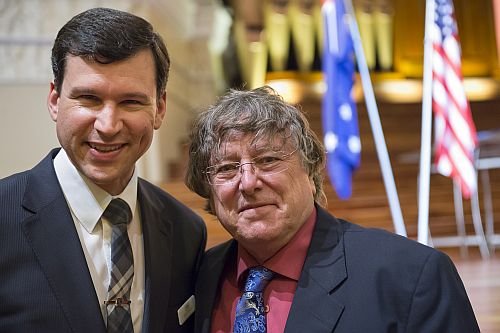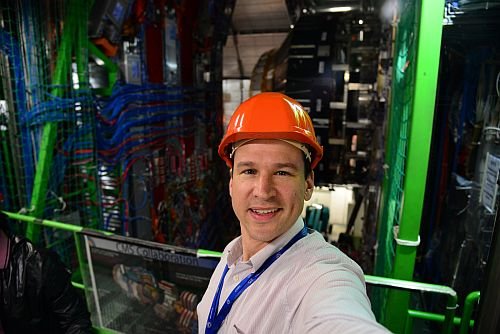Australian researchers may soon be able to examine the intimate details of chemical reactions and biological processes by collecting information billions of times faster than the blink of an eye.
 Dr Mark Boland from the Australian Synchrotron will use his Fulbright Professional Scholarship in Nuclear Science and Technology awarded in March 2014 to enable Australian scientists to measure samples at the Synchrotron at least a thousand times faster than is currently possible.
Dr Mark Boland from the Australian Synchrotron will use his Fulbright Professional Scholarship in Nuclear Science and Technology awarded in March 2014 to enable Australian scientists to measure samples at the Synchrotron at least a thousand times faster than is currently possible.
Photo at right (L-R): Mark Boland with Prof. John Dodson from ANSTO at the Fulbright award ceremony.
The following article is written for readers with some knowledge of physics or synchrotron science. A less-technical explanation is available in the news section of this website.
Mark’s aim is to further extend the Australian Synchrotron’s capabilities so that it can collect real-time information about processes at the level of picoseconds – one trillionth of a second. The Synchrotron is currently capable of collecting data at the nanosecond timescale.
“The time domain is a new frontier in science, complementing the present ability to observe nature on the spatial scale down to the level of individual atoms,” Mark said. “To fully understand the structure of matter and the chemical and biological processes that drive the world around us, we need to be able to perform experiments at picosecond, femtosecond and eventually attosecond time resolution.
“Choosing and preparing samples for study on these timescales is the domain of the chemists, biologists and material scientists who use the synchrotron. Creating and diagnosing the properties of the light source with the picosecond time structure to study the matter around us often falls to the accelerator physicists.”
The technique most relevant to the Australian Synchrotron is the so-called optical pump – x-ray probe or time-resolved technique. This involves using the picosecond length bunches of electrons in the synchrotron storage ring to generate short pulses of x-rays.
From August 2014, Mark will spend six months at the SLAC National Accelerator Laboratory (SLAC) at Stanford University in California. The Australian Synchrotron storage ring is very similar to the SPEAR3 ring at SLAC, and the two facilities have previously collaborated on similar accelerator research. SPEAR3 also recently started a program of picosecond measurements.
“Before researchers can successfully use the short x-ray pulses generated by the accelerator, a key challenge will be to develop good diagnostics with picosecond time resolution so that experiments can be synchronised with the accelerator.
“We’ll build on some promising preliminary results already achieved at the Australian Synchrotron. For example, we’ve demonstrated in principle that we can synchronise beamline detectors with the accelerators on a nanosecond timescale in the x-ray region and a picosecond timescale in the visible light region. And we know we can generate sub ten picosecond bunches using low-alpha mode, because we’ve done this to enhance the infrared part of the spectrum.”
 To complement the more restrictive accelerator tuning required for low-alpha mode, Mark will study so-called ‘camshaft fill’ accelerator operations. In this mode, a large-current single bunch is injected into the storage ring with 60 nanoseconds between it and the electron bunches that precede and follow it. While this doesn’t produce the short bunch lengths achieved in low-alpha mode, it does allow fast-gated detectors to operate in time-resolved mode, only measuring x-rays emitted from the isolated single bunch.
To complement the more restrictive accelerator tuning required for low-alpha mode, Mark will study so-called ‘camshaft fill’ accelerator operations. In this mode, a large-current single bunch is injected into the storage ring with 60 nanoseconds between it and the electron bunches that precede and follow it. While this doesn’t produce the short bunch lengths achieved in low-alpha mode, it does allow fast-gated detectors to operate in time-resolved mode, only measuring x-rays emitted from the isolated single bunch.
Photo at left: The optical diagnostic beamline is currently the only beamline at the Australian Synchrotron that uses instruments sensitive enough to measure with picosecond time resolution (photo: Mark Boland)
From a longer-term, strategic point of view, Mark will also compare the high repetition rate short pulses that are produced at the SPEAR3 storage ring with the low frequency pulses produced by the Linac Coherent Light Source (LCLS) free electron laser (FEL) at SLAC.
“The SPEAR3 technique offers the possibility of more x-rays per second with a longer bunch length. The LCLS produces much shorter bunch lengths but the repetition rate is low, so some experiments may take longer or simply not be possible on an FEL. SLAC’s experience with both techniques will help guide the future direction of time-resolved experiments in Australia. A key question will be the number and range of experiments that can take advantage of the femtosecond timescale pulses from an FEL compared with the picosecond timescale pulses from a storage ring.”
 Mark is the Australian Synchrotron’s Principal Accelerator Physicist. In addition to creating new possibilities for research in Australia, his studies at SLAC will link the Australian community to the more experienced community at SLAC, enhancing the existing accelerator physics collaboration and extending it to the user beamlines at the Australian Synchrotron and SPEAR3.
Mark is the Australian Synchrotron’s Principal Accelerator Physicist. In addition to creating new possibilities for research in Australia, his studies at SLAC will link the Australian community to the more experienced community at SLAC, enhancing the existing accelerator physics collaboration and extending it to the user beamlines at the Australian Synchrotron and SPEAR3.
Photo at right: selfie of Mark Boland in the CMS facility at CERN, September 2013
